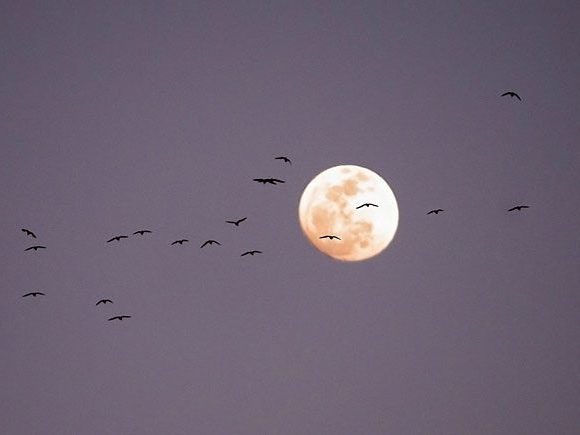Why do migratory birds crash into buildings and how can it be prevented?

Even in the best of circumstances, spring and fall are dangerous times for migrating birds. Most birds migrate at night, and major cities full of brightly lit buildings can draw the birds off course and increase the risk of striking windows.
The reasons are not entirely understood, but nocturnal migrants often navigate by the stars. Illuminated windows and other night lights may divert them from their original flight paths, especially in low-ceiling or foggy conditions. The birds mill about in the lighted area, where they collide with the lighted structure or with reflective windows the next day. In addition to buildings, communications towers and radio antennas pose similar threats. Hundreds or thousands of dead birds may litter city streets after a wave of migrants has passed through. In all, up to 1 billion birds die each year in North America from colliding with structures.
As people learn more about where, when and how these nighttime collisions happen, they are also learning how to prevent them. Since 1993, the Fatal Light Awareness Program (FLAP), a Toronto-based conservation society, has spearheaded “Lights Out” programs across North America, calling for buildings in major cities to turn out all of their lights each night during peak migration times. One study conducted by the Field Museum in Chicago showed that in one building, turning the lights off reduced the number of bird kills by an average of 83%. Birdcast a joint project of the Cornell Lab of Ornithology, Colorado State University, and the University of Massachusetts Amherst analyzes weather surveillance radar to estimate the numbers, flight directions, speeds, and altitudes of birds aloft across the contiguous United States. See Birdcast migration dashboard for more information on birds passing over any counties in the Lower 48. BirdCast also offers resources on how to go Lights Out, and you can sign up for alerts when particularly heavy migration is expected in your area and turning out lights is most beneficial.
In addition to turning out lights, it’s important to make windows safer for birds. And it’s not just skyscrapers that are a problem: millions of birds die in collisions at residences as well. Visit our Window Collisions page for more about window treatments that help prevent collisions in residential areas.
More Information:
- Why Birds Hit Windows—And How You Can Help Prevent It offers suggestions and photos of window treatments that help prevent collisions.
- A Single Night Of Bird Collisions In Chicago Points To The Need For Window Safety, Living Bird Spring 2024
- Dr. Daniel Klem, one of the field’s leading researchers, has information about both problems and solutions on his website
- Bird Injuries From Collisions With Windows: What We Know, And What You Can Do [Video], 2017 seminar by Christine Sheppard, Bird Collisions Campaign Manager, American Bird Conservancy
- Glass Action for Birds, Living Bird, Winter 2014
- Hope For Solving Bird Collisions, a brief report on the problem of bird strikes as discussed at the 2009 meeting of the American Ornithologists’ Union

All About Birds
is a free resource
Available for everyone,
funded by donors like you
American Kestrel by Blair Dudeck / Macaulay Library
